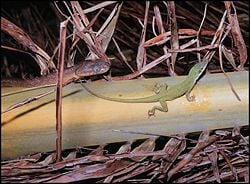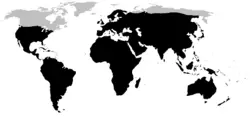Squamata
| Scaled reptiles | ||||||||
|---|---|---|---|---|---|---|---|---|
 Brown tree snake and Green anole
| ||||||||
| Scientific classification | ||||||||
| ||||||||
 black: range of Squamata
| ||||||||
|
see text |
Squamata (scaled reptiles) is the most diverse order of extant reptiles, comprised of the lizards and snakes and characterized a flexible jaw structure (movable quadrate bones) and having scales or shields rather than shells or secondary palates. Of the four surviving ordersâthe others being Crocodilia, Rhynchocephalia, and Testudinesâthe squamates represent more than 95 percent of the known living species (Uetz 2000).
Despite their diverse formsâsuch as the lack of legs in snakes, presence of legs in lizards, and resemblance of the amphisbaenians to wormsâsquamates share many of the same traits. Some of these characters are not shared with any other reptiles, and in the case of paired penes, with any other vertebrates. This reflects that all squamates belong to the same lineage, as descendants of a common ancestor.
Overview
Reptiles are tetrapods (four-legged vertebrates) and amniotes (animals whose embryos are surrounded by an amniotic membrane that encases it in amniotic fluid). Reptiles have traditionally been defined as including all the amniotes except birds and mammals.
Today, reptiles are represented by four surviving orders:
- Squamata (lizards, snakes, and amphisbaenids ("worm-lizards")
- Crocodilia (crocodiles, caimans, and alligators)
- Rhynchocephalia (tuataras from New Zealand)
- Testudines (turtles)
According to Uetz (2000), there are a total of 7,870 extant species of reptiles, with the majority being lizards (4,470 species) and snakes (2,920), and with 156 amphisbaenias, 23 described species of living crocodiles, 295 species of turtles, and 2 species of tuataras. Similarly, Grzimet et al. (2004) note 1,440 genera and 4,450 species of lizards and 440 genera and 2,750 species of snakes. In all, this means that almost 96 percent of living reptiles belong to the Squamata order.
Squamata is considered to be a natural monophyletic group, with all squamates being descendants of a common ancestor (Grzimek et al. 2004). They have more than 70 shared derived traits (Grzimek et al. 2004). The lizards (suborder Lacertilia or Sauria) by themselves are considered to form a paraphyletic group.
Members of the Squamata order particularly are known to all possess movable quadrate bones, making it possible to move the upper jaw relative to the braincase. This is particularly visible in snakes, which are able to open their mouths very widely to accommodate comparatively large prey. Other shared traits include having only a single temporal opening or it is lost or reduced, a highly modified skull, and with the male members of the group Squamata being the only vertebrates with a hemipenis (possessing paired penes). They also are distinguished by their skins, which bear horny scales or shields, while lacking any shells or secondary palates. This is also the only reptile group in which can be found both viviparous and ovoviviparous species, as well as the usual oviparous reptiles.
Classification
Classical
Classically, the Squamata order is divided into three suborders:
- Lacertilia, the lizards;
- Serpentes, the snakes;
- Amphisbaenia, the worm lizards.
Benton (2000) considers Amphisbaenia to be an infraorder within the Squamata Order, while considering the lizards (Lacertilia or Sauria) and snakes (Serpentes or Ophidia) to be orders. Uetz (2007) considers Amphisbaenia to be an suborder as with the lizards and snakes.
New classification
In newer classifications, the name Sauria is used for reptiles and birds in general, and the Squamata are divided differently:
- Suborder Iguania (the iguanas and chameleons)
- Suborder Scleroglossa
In this newer classification, Iguania is now believed to represent a separate lineage from the others, which are placed in the suborder Schleroglossa. The exact relationships within these two suborders are not entirely certain yet, though recent research strongly suggests that several families form a venom clade which encompasses a majority (nearly 60 percent) of Squamate species.
The Squamata do not include the tuataras, New Zealand reptiles resembling lizards.
ReferencesISBN links support NWE through referral fees
- Benton, M. J. 2004. Vertebrate Paleontology, 3rd ed. Blackwell Science. ISBN 0632056371.
- Evans, S. E., and L. J. Barbadillo. 1998: An unusual lizard (Reptilia: Squamata) from the Early Cretaceous of Las Hoyas, Spain. Zoological Journal of the Linnean Society. 124: 235-265.
- Grzimek, B., D. G. Kleiman, V. Geist, and M. C. McDade. 2004. Grzimek's Animal Life Encyclopedia. Detroit: Thomson-Gale. ISBN 0787657883.
- Kazlev, M. A. 2007. Squamata: Overview. Palaeos.com. Retrieved November 30, 2007.
- Myers, P., R. Espinosa, C. S. Parr, T. Jones, G. S. Hammond, and T. A. Dewey. 2006. Order Squamata (amphisbaenians, lizards, and snakes). Animal Diversity Web (online). Retrieved November 30, 2007.
- Uetz, P. 2000. How many reptile species? Herpetological Review 31(1):13â15.
- Uetz, P. 2007. Order Squamata. Reptile-database.org. Retrieved November 30, 2007.
Credits
New World Encyclopedia writers and editors rewrote and completed the Wikipedia article in accordance with New World Encyclopedia standards. This article abides by terms of the Creative Commons CC-by-sa 3.0 License (CC-by-sa), which may be used and disseminated with proper attribution. Credit is due under the terms of this license that can reference both the New World Encyclopedia contributors and the selfless volunteer contributors of the Wikimedia Foundation. To cite this article click here for a list of acceptable citing formats.The history of earlier contributions by wikipedians is accessible to researchers here:
The history of this article since it was imported to New World Encyclopedia:
Note: Some restrictions may apply to use of individual images which are separately licensed.